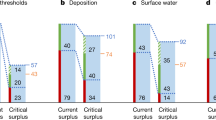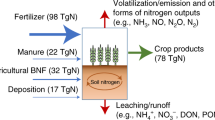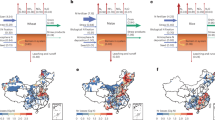Abstract
While nitrogen inputs are crucial to agricultural production, excess nitrogen contributes to serious ecosystem damage and water pollution. Here, we investigate this trade-off using an integrated modelling framework. We quantify how different nitrogen mitigation options contribute to reconciling food security and compliance with regional nitrogen surplus boundaries. We find that even when respecting regional nitrogen surplus boundaries, hunger could be substantially alleviated with 590 million fewer people at risk of hunger from 2010 to 2050, if all nitrogen mitigation options were mobilized simultaneously. Our scenario experiments indicate that when introducing regional N targets, supply-side measures such as the nitrogen use efficiency improvement are more important than demand-side efforts for food security. International trade plays a key role in sustaining global food security under nitrogen boundary constraints if only a limited set of mitigation options is deployed. Policies that respect regional nitrogen surplus boundaries would yield a substantial reduction in non-CO2 GHG emissions of 2.3 GtCO2e yr−1 in 2050, which indicates a necessity for policy coordination.
This is a preview of subscription content, access via your institution
Access options
Access Nature and 54 other Nature Portfolio journals
Get Nature+, our best-value online-access subscription
$32.99 / 30 days
cancel any time
Subscribe to this journal
Receive 12 digital issues and online access to articles
$119.00 per year
only $9.92 per issue
Buy this article
- Purchase on SpringerLink
- Instant access to full article PDF
Prices may be subject to local taxes which are calculated during checkout





Similar content being viewed by others
Data availability
The main data that support the findings of this study are available at the public Data Repository of the International Institute of Applied Systems Analysis (https://dare.iiasa.ac.at/125/ and https://doi.org/10.22022/IBF/07-2021.125). Source data are provided with this paper.
Code availability
The code used for the statistical analysis of the scenario data is available from the corresponding author on request.
Change history
03 May 2022
A Correction to this paper has been published: https://doi.org/10.1038/s43016-022-00522-x
References
Sutton, M. A. et al. Our Nutrient World: The Challenge to Produce More Food and Energy with Less Pollution (Centre for Ecology and Hydrology, 2013).
Cohen, A. J. et al. Estimates and 25-year trends of the global burden of disease attributable to ambient air pollution: an analysis of data from the Global Burden of Diseases Study 2015. Lancet 389, 1907–1918 (2017).
Review of Evidence on Health Aspects of Air Pollution—REVIHAAP Project (WHO, 2013).
Cape, J. N., van der Eerden, L. J., Sheppard, L. J., Leith, I. D. & Sutton, M. A. Evidence for changing the critical level for ammonia. Environ. Pollut. 157, 1033–1037 (2009).
Tian, H. et al. Global soil nitrous oxide emissions since the preindustrial era estimated by an ensemble of terrestrial biosphere models: magnitude, attribution, and uncertainty. Glob. Change Biol. 25, 640–659 (2019).
Rabalais, N. N., Turner, R. E., Díaz, R. J. & Justić, D. Global change and eutrophication of coastal waters. ICES J. Mar. Sci. 66, 1528–1537 (2009).
Smith, V. H. & Schindler, D. W. Eutrophication science: where do we go from here? Trends Ecol. Evol. 24, 201–207 (2009).
van Grinsven, H. J. M., Rabl, A. & de Kok, T. M. Estimation of incidence and social cost of colon cancer due to nitrate in drinking water in the EU: a tentative cost–benefit assessment. Environ. Health 9, 58 (2010).
Seitzinger, S. P. et al. Global river nutrient export: a scenario analysis of past and future trends. Glob. Biogeochem. Cycles https://doi.org/10.1029/2009gb003587 (2010).
Rockström, J. et al. A safe operating space for humanity. Nature 461, 472 (2009).
Steffen, W. et al. Planetary boundaries: guiding human development on a changing planet. Science 347, 1259855 (2015).
Springmann, M. et al. Options for keeping the food system within environmental limits. Nature 562, 519–525 (2018).
Hillebrand, H. et al. Thresholds for ecological responses to global change do not emerge from empirical data. Nat. Ecol. Evol. 4, 1502–1509 (2020).
De Vries, W., Kros, J., Kroeze, C. & Seitzinger, S. P. Assessing planetary and regional nitrogen boundaries related to food security and adverse environmental impacts. Curr. Opin. Environ. Sustain. 5, 392–402 (2013).
Lewis, S. We must set planetary boundaries wisely. Nature 485, 417 (2012).
Sutton, M. A. et al. The European Nitrogen Assessment: Sources, Effects and Policy Perspectives (Cambridge Univ. Press, 2011).
Yu, C. et al. Managing nitrogen to restore water quality in China. Nature 567, 516–520 (2019).
Kanter, D. R., Chodos, O., Nordland, O., Rutigliano, M. & Winiwarter, W. Gaps and opportunities in nitrogen pollution policies around the world. Nat. Sustain. 3, 956–963 (2020).
Sinha, E., Michalak, A. M., Calvin, K. V. & Lawrence, P. J. Societal decisions about climate mitigation will have dramatic impacts on eutrophication in the 21st century. Nat. Commun. 10, 939 (2019).
Gu, B., Ju, X., Chang, J., Ge, Y. & Vitousek, P. M. Integrated reactive nitrogen budgets and future trends in China. Proc. Natl Acad. Sci. USA 112, 8792–8797 (2015).
Tilman, D., Balzer, C., Hill, J. & Befort, B. L. Global food demand and the sustainable intensification of agriculture. Proc. Natl Acad. Sci. USA 108, 20260–20264 (2011).
Bouwman, L. et al. Exploring global changes in nitrogen and phosphorus cycles in agriculture induced by livestock production over the 1900–2050 period. Proc. Natl Acad. Sci. USA 110, 20882–20887 (2013).
Bodirsky, B. L. et al. Reactive nitrogen requirements to feed the world in 2050 and potential to mitigate nitrogen pollution. Nat. Commun. 5, 3858 (2014).
Folberth, C. et al. The global cropland-sparing potential of high-yield farming. Nat. Sustain. 3, 281–289 (2020).
Gerten, D. et al. Feeding ten billion people is possible within four terrestrial planetary boundaries. Nat. Sustain. 3, 200–208 (2020).
Havlík, P. et al. Global land-use implications of first and second generation biofuel targets. Energy Policy 39, 5690–5702 (2011).
Kros, J. et al. Uncertainties in model predictions of nitrogen fluxes from agro-ecosystems in Europe. Biogeosciences 9, 4573–4588 (2012).
De Vries, W. et al. Comparison of land nitrogen budgets for European agriculture by various modeling approaches. Environ. Pollut. 159, 3254–3268 (2011).
Food Security Indicators (FAO, 2016); http://www.fao.org/economic/ess/ess-fs/ess-fadata/en/#.XdcGvjK2lp-
Fricko, O. et al. The marker quantification of the Shared Socioeconomic Pathway 2: a middle-of-the-road scenario for the 21st century. Glob. Environ. Change 42, 251–267 (2017).
Elleby, C., Domínguez, I. P., Adenauer, M. & Genovese, G. Impacts of the COVID-19 pandemic on the global agricultural markets. Environ. Resour. Econ. 76, 1067–1079 (2020).
Frank, S. et al. Agricultural non-CO2 emission reduction potential in the context of the 1.5 °C target. Nat. Clim. Change 9, 66–72 (2019).
Alexander, R. B. et al. Differences in phosphorus and nitrogen delivery to the Gulf of Mexico from the Mississippi River basin. Environ. Sci. Technol. 42, 822–830 (2008).
Hasegawa, T. et al. Risk of increased food insecurity under stringent global climate change mitigation policy. Nat. Clim. Change 8, 699–703 (2018).
Hasegawa, T., Havlík, P., Frank, S., Palazzo, A. & Valin, H. Tackling food consumption inequality to fight hunger without pressuring the environment. Nat. Sustain. 2, 826–833 (2019).
Fujimori, S. et al. A multi-model assessment of food security implications of climate change mitigation. Nat. Sustain. 2, 386–396 (2019).
Femenia, F. A Meta-analysis of the Price and Income Elasticities of Food Demand Working Paper SMART—LERECO No. 19-03 (INRAE, 2019).
The Fertilizer Industry, World Food Supplies and the Environment (IFA, UNEP, 1998).
Ammonia Production: Moving Towards Maximum Efficiency and Lower GHG Emissions (IFA, 2014); https://www.fertilizer.org/images/Library_Downloads/2014_ifa_ff_ammonia_emissions_july.pdf
Houlton, B. Z. et al. A world of cobenefits: solving the global nitrogen challenge. Earth’s Future 7, 865–872 (2019).
Balkovič, J. et al. Global wheat production potentials and management flexibility under the representative concentration pathways. Glob. Planet. Change 122, 107–121 (2014).
Parton, W. J. et al. Observations and modeling of biomass and soil organic matter dynamics for the grassland biome worldwide. Glob. Biogeochem. Cycles 7, 785–809 (1993).
Herrero, M. et al. Biomass use, production, feed efficiencies, and greenhouse gas emissions from global livestock systems. Proc. Natl Acad. Sci. USA 110, 20888–20893 (2013).
Kindermann, G. et al. Global cost estimates of reducing carbon emissions through avoided deforestation. Proc. Natl Acad. Sci. USA 105, 10302–10307 (2008).
Leclère, D. et al. Bending the curve of terrestrial biodiversity needs an integrated strategy. Nature 585, 551–556 (2020).
Popp, A. et al. Land-use futures in the shared socio-economic pathways. Glob. Environ. Change 42, 331–345 (2017).
Stehfest, E. et al. Key determinants of global land-use projections. Nat. Commun. 10, 2166 (2019).
Valin, H. et al. The future of food demand: understanding differences in global economic models. Agric. Econ. 45, 51–67 (2014).
Havlík, P. et al. Climate change mitigation through livestock system transitions. Proc. Natl Acad. Sci. USA 111, 3709–3714 (2014).
Zhang, X. et al. Managing nitrogen for sustainable development. Nature 528, 51–59 (2015).
Smil, V. Nitrogen in crop production: an account of global flows. Glob. Biogeochem. Cycles 13, 647–662 (1999).
Sheldrick, W. F., Syers, J. K. & Lingard, J. A conceptual model for conducting nutrient audits at national, regional, and global scales. Nutr. Cycling Agroecosyst. 62, 61–72 (2002).
Liu, J. et al. A high-resolution assessment on global nitrogen flows in cropland. Proc. Natl Acad. Sci. USA 107, 8035–8040 (2010).
Bodirsky, B. L. et al. N2O emissions from the global agricultural nitrogen cycle—current state and future scenarios. Biogeosciences 9, 4169–4197 (2012).
Uwizeye, A. et al. Nitrogen emissions along global livestock supply chains. Nat. Food 1, 437–446 (2020).
Rosenzweig, C. et al. Assessing agricultural risks of climate change in the 21st century in a global gridded crop model intercomparison. Proc. Natl Acad. Sci. USA 111, 3268–3273 (2014).
van Vuuren, D. P. et al. The representative concentration pathways: an overview. Climatic Change 109, 5 (2011).
Collins, W. J. et al. Development and evaluation of an Earth-system model—HadGEM2. Geosci. Model Dev. 4, 1051–1075 (2011).
IPCC Climate Change 2014: Synthesis Report (eds Core Writing Team, Pachauri, R. K. & Meyer, L. A.) (IPCC, 2014).
Leclère, D. et al. Climate change induced transformations of agricultural systems: insights from a global model. Environ. Res. Lett. 9, 124018 (2014).
Havlík, P. et al. in Climate Change and Food Systems: Global Assessments and Implications for Food Security and Trade (ed. Elbehri, A.) 177–208 (FAO, 2015).
Müller, C. & Robertson, R. D. Projecting future crop productivity for global economic modeling. Agric. Econ. 45, 37–50 (2014).
Nelson, G. C. et al. Climate change effects on agriculture: economic responses to biophysical shocks. Proc. Natl Acad. Sci. USA 111, 3274–3279 (2014).
De Vries, W. & Schulte-Uebbing, L. Required changes in nitrogen inputs and nitrogen use efficiencies to reconcile agricultural productivity with water and air quality objectives in the EU-27. In Proc. 842 of the International Fertiliser Society 1–39 (nternational Fertiliser Society, Cambridge, 2020).
Camargo, J. A. & Alonso, Á. Ecological and toxicological effects of inorganic nitrogen pollution in aquatic ecosystems: a global assessment. Environ. Int. 32, 831–849 (2006).
Laane, R. W. P. M. Applying the critical load concept to the nitrogen load of the river Rhine to the Dutch coastal zone. Estuar. Coast. Shelf Sci. 62, 487–493 (2005).
Velthof, G. L. et al. Integrated assessment of nitrogen losses from agriculture in EU-27 using MITERRA-EUROPE. J. Environ. Qual. 38, 402–417 (2009).
Dieng, H. B. et al. Total land water storage change over 2003–2013 estimated from a global mass budget approach. Environ. Res. Lett. 10, 124010 (2015).
Dai, A. & Trenberth, K. E. Estimates of freshwater discharge from continents: latitudinal and seasonal variations. J. Hydrometeorol. 3, 660–687 (2002).
Harris, I. C. CRU JRA v1. 1: A Forcings Dataset of Gridded Land Surface Blend of Climatic Research Unit (CRU) and Japanese Reanalysis (JRA) Data 2905th edn, Vol. 2905 (University of East Anglia Climatic Research Unit Centre for Environmental Data Analysis, 2019).
Mueller, B. et al. Benchmark products for land evapotranspiration: LandFlux-EVAL multi-data set synthesis. Hydrol. Earth Syst. Sci. 17, 3707–3720 (2013).
Klein Goldewijk, K., Beusen, A., Doelman, J. & Stehfest, E. Anthropogenic land use estimates for the Holocene–HYDE 3.2. Earth Syst. Sci. Data 9, 927 (2017).
FAO, IFAD, UNICEF, WFP & WHO The State of Food Security and Nutrition in the World 2019: Safeguarding Against Economic Slowdowns and Downturns (FAO, 2019).
Methodology for the Measurement of Food Deprivation: Updating the Minimum Dietary Energy Requirements (FAO, 2008).
Hasegawa, T., Fujimori, S., Takahashi, K. & Masui, T. Scenarios for the risk of hunger in the twenty-first century using Shared Socioeconomic Pathways. Environ. Res. Lett. 10, 014010 (2015).
Hasegawa, T. et al. Consequence of climate mitigation on the risk of hunger. Environ. Sci. Technol. 49, 7245–7253 (2015).
Energy and Protein Requirements: Report of a Joint FAO/WHO Ad Hoc Expert Committee World Health Organization Technical Report Series No. 522; FAO Nutrition Meetings Report Series No. 52 (WHO, FAO, 1973).
Kc, S. & Lutz, W. The human core of the shared socioeconomic pathways: population scenarios by age, sex and level of education for all countries to 2100. Glob. Environ. Change 42, 181–192 (2017).
Drawing Down N2O to Protect Climate and the Ozone Layer: A UNEP Synthesis Report (United Nations Environment Programme, 2013).
Kanter, D. R. et al. A framework for nitrogen futures in the shared socioeconomic pathways. Glob. Environ. Change 61, 102029 (2020).
Van Drecht, G., Bouwman, A. F., Harrison, J. & Knoop, J. M. Global nitrogen and phosphate in urban wastewater for the period 1970 to 2050. Glob. Biogeochem. Cycles https://doi.org/10.1029/2009gb003458 (2009).
Transforming Our World: the 2030 Agenda for Sustainable Development (United Nations, 2015).
Lassaletta, L., Billen, G., Grizzetti, B., Anglade, J. & Garnier, J. 50 year trends in nitrogen use efficiency of world cropping systems: the relationship between yield and nitrogen input to cropland. Environ. Res. Lett. 9, 105011 (2014).
Gustavsson, J., Cederberg, C., Sonesson, U., Van Otterdijk, R. & Meybeck, A. Global Food Losses and Food Waste – Extent, Causes and Prevention (FAO, 2011).
Acknowledgements
J.C. and M.O. were supported by European Research Council Synergy grant no. ERC-2013-SynG-610028 Imbalance-P. Support from the Global Environment Facility of the United Nations Environment Programme through the project ‘Towards an International Nitrogen Management System’ for the organization of workshops proved essential to the success of this work.
Author information
Authors and Affiliations
Contributions
J.C. and P.H. designed the study. J.C. carried out the GLOBIOM modelling with help from P.H., D.L., H.V. and A.D. W.d.V. provided the methodology for estimating regional N surplus boundaries. J.C. performed the analysis and wrote an initial draft. All authors contributed substantially to the interpretation of the results and to the text.
Corresponding author
Ethics declarations
Competing interests
The authors declare no competing interests.
Additional information
Peer review information Nature Food thanks Thomas Nesme, Aimable Uwizeye and the other, anonymous, reviewer(s) for their contribution to the peer review of this work.
Publisher’s note Springer Nature remains neutral with regard to jurisdictional claims in published maps and institutional affiliations.
Supplementary information
Supplementary Information
Supplementary Notes 1–5, Tables 1–10 and Figs. 1–8.
Source data
Source Data Fig. 2
Source data for Fig. 2.
Source Data Fig. 3
Source data for Fig. 3.
Source Data Fig. 4
Source data for Fig. 4.
Source Data Fig. 5
Source data for Fig. 5.
Rights and permissions
About this article
Cite this article
Chang, J., Havlík, P., Leclère, D. et al. Reconciling regional nitrogen boundaries with global food security. Nat Food 2, 700–711 (2021). https://doi.org/10.1038/s43016-021-00366-x
Received:
Accepted:
Published:
Issue date:
DOI: https://doi.org/10.1038/s43016-021-00366-x
This article is cited by
-
Data-driven strategies to improve nitrogen use efficiency of rice farming in South Asia
Nature Sustainability (2025)
-
Synergy between SDGs 12.3 and 2.1 in lower-middle-income countries through the lens of food waste and energy imbalance
Scientific Reports (2025)
-
The optimum nitrogen fertilizer rate for maize in the US Midwest is increasing
Nature Communications (2025)
-
Cost-effective adaptations increase rice production while reducing pollution under climate change
Nature Food (2025)
-
Multiple planetary boundaries preclude biomass crops for carbon capture and storage outside of agricultural areas
Communications Earth & Environment (2025)



